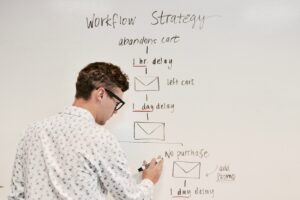Customer lifetime value (CLV) is how much a customer is expected to pay for your products or services during their lifetime. Ideally, you want this number to be as high as possible – but that means you have to work for it. All your competitors want that value to be diverted away from you and into their own bottom lines, after all. So, what’s the solution? A multi-pronged approach is best, and one key element it should include is engaging email marketing. Here are several ways to use your automated email flows to keep those customers coming back for more, again and again, from our email marketing team.
How to Calculate CLV
This is a pretty simple formula:
CLV = (Average Order Value) x (Number of Purchases Per Customer Per Year) x (Avg. Length of the Customer Relationship in Years)
It’s a useful one too, helping you to determine how much money you should invest in retaining existing customers vs. attracting new ones.
#1 – The Post-Purchase Email Marketing Sequence
On the day – This sequence starts by thanking your customer for making a purchase from you and can include a section for feedback on their online or in-store experience, the products they bought, or what they’d like to see more of.
2 days later – Next, you can send an email giving them insights or information on the products they purchased – how to use them, directions to FAQs, an instructive video, or supporting blog content.
One week on – The third step is to ask for your customer to send in a review of their purchases. This can be rewarded with a discount on their next purchase or shipping costs, loyalty points, or entry for a prize.
#2 – The Cross-Sell or Upsell Email Marketing Sequence
This is about sending your customers information on products based on the purchases they’ve made. If they bought running shoes, suggest activewear or an activity tracker. If they’ve bought a cookbook, suggest kitchenware and prep tools. You get the idea. Of course, the more purchases your customer has completed, the more data you have to use, so it’s a good idea to introduce wish lists to give you a clear idea of what they want. You can also look at data from other customers who have purchased those products to see likely recommendations.
You can send out these emails after a purchase has been made (2-3 days later), timing it for when your customer has most likely used your product and is happy with the results.
Restocking Email Marketing Sequence
If you sell products that get used up or expire (food, lotions and toiletries, cleaning supplies, office supplies, supplements, perishables, etc) then this is a great email sequence for you. The idea is that you want this email to land in your customer’s inbox just when they start thinking “Hm, I need to get more of that”.
Take a look at your repeat customers and last order dates to get an idea of when your customer is about to run out of stock, then send them an email one week before the anticipated date. Include blog information on the product, other reviews, etc. Send a follow-up email 3 days before the anticipated date, possibly with a countdown timer or discount offer for purchases in the next 24 hours.
Winning You Back Email Marketing Sequence
This campaign is about reminding customers who have been inactive for 4-6 months who you are and what you offer, and is especially important for the upcoming festive season.
Use a catchy subject line, showcase all your latest, greatest offerings, update them on what your business is doing right now, and offer them a limited time discount to show you miss them and want them back.
Send one email out every 4 months to lapsed and inactive customers, but be sure to cull email addresses where the emails bounce or where you don’t get a response in over a year.






